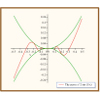Analysis Seminar
Consider axisymmetric initial data for the Einstein
equations, having two ends, one asymptotically flat or asymptotically
hyperbolic and the other either asymptotically flat or asymptotically
cylindrical.
Heuristic physical arguments lead to the following inequality
$m\geq\sqrt{|J|}$ relating the total mass and angular momentum. Equality
should be achieved if and only if the data arise from the exrteme Kerr
spacetime. When the designated end is asymptotically flat, Dain
established this inequality (along with the corresponding rigidity
statement) when the data are maximal and vacuum, and subsequently
several authors have improved upon and extended these results. Here we
consider the general non-maximal case in which the matter fields
satisfy the dominant energy condition, and introduce a natural
deformation back to the maximal case which preserves all the relevant
geometry. This procedure may then be used to establish the angular
momentum-mass inequality (and rigidity statement) in the general case,
assuming that a solution exists to a canonical system of two elliptic
equations. This is joint work with Ye Sle Cha.
When the designated end is asymptotically hyperbolic (modeling
asymptotically null slices in asymptotically Minkowski spacetimes),
similar results hold. This is joint work with Anna Sakovich.
